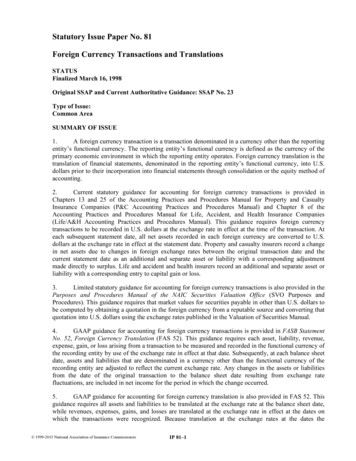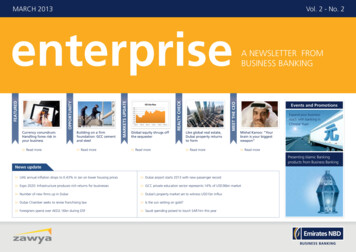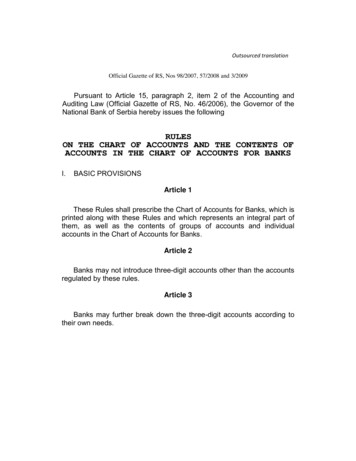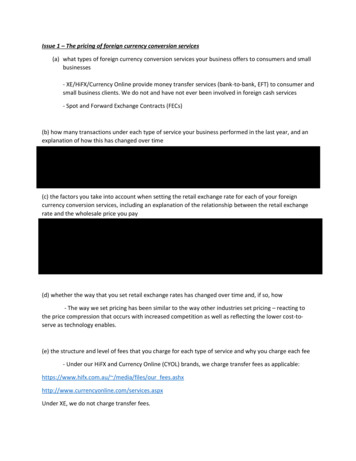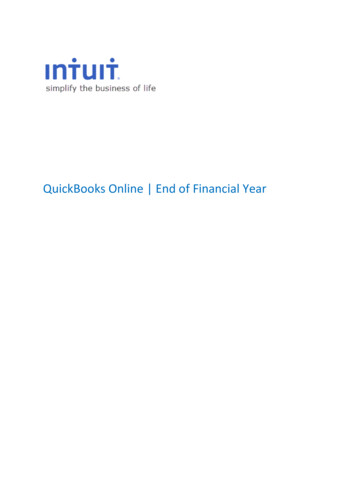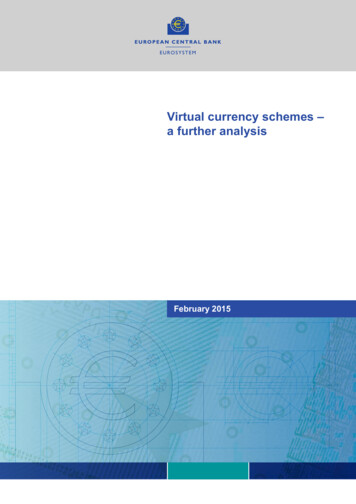
Transcription
ACCOUNTING FOR FOREIGN CURRENCY TRANSACTIONSAS-11Prepared byDr. Himanshi Mansukhani
Contents: Objectives Introduction Accounting Standard No.11 (Revised) Accounting procedure Journal Entries
OBJECTIVES Know the meaning of Foreign currency transactions Understand the Need for conversion Explain the Recognition of exchange fluctuation Know the Translation of foreign currency transactions Solve the practical problems on Foreign currency transactions
INTRODUCTION A transaction like sale or purchase of goods involves two parties. Wheneversuch transaction is entered with another party situated in India, thetransaction is in Indian currency, recording of such transaction does not poseany problem. But if the other party is located outside India then thetransaction entered might be in foreign currency and then we have totranslate this transaction from foreign currency into India currency. Thistranslation is done by applying the foreign exchange rates prevailing at thetime of transaction. Accounting Standard No.11 deals with recording andtranslation of such type of foreign currency transactions.
SCOPE:(Accounting Standard -11) The standard should be applied in accounting for transactions entered in foreigncurrencies. This standard also deals with accounting for foreign currency transactions in thenature of forward exchange contracts. This standard does not specify the currency of presentation of financial statements.Normally an organization prepares its financial statements in currency of homecountry. The standard does not deal with the restatement of an enterprise's financialstatements from its reporting currency into another currency for the conveniencefor user accustomed to that currency of for similar purpose. This standard does not deal with the presentation in a cash flow statement of cashflows arising from transactions in a foreign currency and the transactions of cashflows of a foreign operation. This standard does not deal with the exchange difference arising from foreigncurrency borrowings to the extent that they are regarded as an adjustment interestcost.
DEFINITIONS: Average rate is the mean of the exchange rates in force duringa period. Closing rate is the exchange rate at the Balance Sheet date. Exchange Difference is the difference resulting from reportingthe same number of units of a foreign currency in thereporting currency at different exchange rates Exchange rate is the ratio for exchange of two currencies. Fair value is the amount for which an asset could be exchangedor a liability settled, between knowledgeable, willing partiesin an arm's length transaction.
Monetary items are money held and assets and liabilities tobe received or paid in fixed or determinable amounts ofmooneye's. Cash, Receivables, Payables etc. Non-monetary items are assets and liabilities other thanmonetary items Fixed Assets, Inventories, Investments etc. Reporting currency is the currency used in presenting thefinancial statements. Foreign Currency is a currency other than the reportingcurrency of an enterprise.
ACCOUNTING PROCEDURE: Record the initial transaction entered in foreign currency by converting inIndian Rs. by multiplying the transaction amount with the foreign exchangerate as on the date of transaction. Subsequently when the payment is made or is received in the same year itshould be recorded at foreign exchange rate on the date of settlement. Anyprofit or loss arising due to exchange fluctuation should be treated as revenueitem, and hence it should be transferred to profit and loss A/c. at the end ofthe year. Any balance payable or receivable to or from a foreign party, at the end ofyear ,should be adjusted at the closing foreign exchange rate. The foreign exchange rate for any payment made or received in thesubsequent year should be compared with the closing rate of the earlier yearto find the profit or loss on exchange fluctuations
JOURNAL ENTRIES :Following four types of transactions are required to betranslated.I.Import of goodsII.Export of goodsIII.Purchase of Fixed Assets
Import of goodsSr no.particulars1.Purchase of goods/ raw materialsPurchases A/cDr.To Foreign Supplier A/c2.Payment to foreign supplierForeign Supplier A/cDr.Foreign Exchange Fluctuation A/c (if loss) Dr.To Foreign exchange Fluctuation A/c(if Profit)To Bank A/c3.Year end adjustmentsA.Adjusting closing balance payable to foreign suppliers (if Loss)Foreign Exchange Fluctuation A/cTo Foreign Supplier A/c.Dr.
(if Profit)Foreign Supplier A/c.DrTo Foreign Exchange Fluctuation A/cB.Closing of nominal A/c. (if Profit)Foreign Exchange Fluctuation A/cDr.To Profit & Loss A/c(if Loss)Profit & Loss A/cDrTo Foreign Exchange Fluctuation A/c4.Payment to foreign supplier in the next yearForeign Supplier A/cDr.Foreign Exchange Fluctuation A/c (if loss) Dr.To exchange Fluctuation A/c(if profit)To Bank A/c
Export of goodsSr no.particulars1.Foreign Customer A/cDr.To Export Sales A/c2.Receiving Payment from Foreign CustomerBank A/c.Dr.Foreign Exchange Fluctuation A/c. (If Loss)To Foreign Exchange Fluctuation A/c. (If profit)To foreign Customer A/c.3.Year end adjustmentsA.Adjusting Closing balance receivable from foreign customerForeign customer A/cDrTo Foreign Exchange Fluctuation A/cDr.
(if Profit)Foreign Exchange Fluctuation A/cDrTo Foreign customer A/cB.Closing of nominal A/c. (if Profit)Foreign Exchange Fluctuation A/cDr.To Profit & Loss A/c(if Loss)Profit & Loss A/cDrTo Foreign Exchange Fluctuation A/c4.Receiving payment from foreign customer in the next YearBank A/c.Dr.Foreign Exchange Fluctuation A/c (if loss) Dr.To exchange Fluctuation A/c(if profit)To foreign Customer A/c.
Purchase of Fixed AssetsSr no.particulars1.Fixed Assets A/cDr.To Foreign Supplier A/c.2.Payment To foreign supplierForeign Supplier A/cDr.Foreign Exchange Fluctuation A/c. (If Loss)To Foreign Exchange Fluctuation A/c. (If profit)To Bank A/c.3.Year end adjustmentsA.Adjusting closing balance payable to foreign suppliers if LossForeign Exchange Fluctuation A/c Dr.To Foreign Supplier A/c.Dr.
(if Profit)Foreign Supplier A/c.DrTo Foreign Exchange Fluctuation A/cB.Providing DepreciationDepreciation A/c.Dr.To Fixed Assets A/c.Note: Depreciation should be provided on original amountC.Closing of nominal A/c. (if Profit)i.Foreign Exchange Fluctuation A/cDr.To Profit & Loss A/c(if Loss)ii.Profit & Loss A/cTo Foreign Exchange Fluctuation A/cDr
iiiProfit & Loss A/c.Dr.To Depreciation A/c4.Payment to foreign supplier in the next yearForeign Supplier A/cDr.Foreign Exchange Fluctuation A/c (if loss) Dr.To exchange Fluctuation A/c(if profit)To Bank A/c
DEFINITIONS: Average rate is the mean of the exchange rates in force during a period. Closing rate is the exchange rate at the Balance Sheet date. Exchange Difference is the difference resulting from reporting the same number of units of a foreign currency in the reporting currency at different exchange rates Exchange rate is the ratio for exchange of two currencies.

